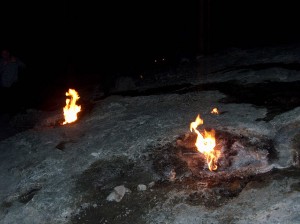11 December 2013
Mythical microbes at the deep Earth interface
In ancient Greek portrayals of Hades, the underworld is a shadowy, unforgiving subterranean expanse, whose five rivers include Phlegethon, a river of fire. At Yanartas in modern-day Turkey, that mythological river of fire flows up into the living world. Methane gas from Earth’s mantle seeps to the surface, fueling flames in the side of Mount Chimera, once believed to be the home of a fire-breathing monster.
While scientists are unlikely to find any three-headed beasts beneath Earth’s surface, the real denizens of the underworld are almost as strange. Without light or oxygen, microbes seem to survive at this depth thanks to unconventional metabolic strategies, like making use of methane. Kristin Woycheese, a graduate student at the University of Illinois at Chicago, is using DNA sequences from these deep-biosphere-dwelling bugs to learn more about their lifestyles. She presented her latest findings in a poster Monday afternoon at the American Geophysical Union’s Fall Meeting.
Yanartas is one of just a few sites where serpentinizing seeps from Earth’s crust and upper mantle emerge on land. Rock from the mantle interacts with water to form serpentine, a greenish mineral that may take its name from its serpent-like hue. Methane and hydrogen form as byproducts, providing food for microbial life.
Serpentinization usually arises at tectonic plate boundaries along the sea floor, but at ophiolites—Greek for “snake stones”—sections of serpentinizing rock are pushed up and exposed on land, forming hydrothermal vents. Since they don’t require drilling, ophiolites are far more amenable to study than sites on the ocean floor.
To find out what microbes might lurk beneath Earth’s surface, Woycheese and her collaborators gathered sediments from ophiolites at Yanartas and Manleluag Hot Spring in the Philippines. They performed high-throughput sequencing on amplified ribosomal DNA to characterize the microbial communities at each site.
Although types of bacteria and archaea showed different distributions at the two sites, the metabolic capabilities of the communities were similar. The researchers expect microbes at both sites can oxidize ammonia, produce (and possibly consume) methane, and ferment hydrocarbons. They also found evidence of microbes that can form spores and biofilms, both protective strategies in the extreme environment of deep Earth.
Woycheese plans to sequence the metagenomes of these microbial communities. The more extensive sequences may reveal which enzymes allow the hardy bugs to make the most of the chemical energy that surrounds them. Moreover, RNA sequencing may show which microbes are truly living and expressing their genes in the serpentinizing seeps.
Still more exciting to Woycheese is the question of how these invaders from the deep might affect ecosystems at Earth’s surface. Geobiologists are beginning to draw tantalizing parallels between serpentinizing seeps and the conditions of the early Earth, and even to possibly life-supporting conditions on other planets. Indulging in a kind of new mythology, Woycheese mused, “In our past we might have been deep subsurface microbes.”
– Molly Sharlach is a science communication graduate student at UC Santa Cruz











 GeoSpace is a blog on Earth and space science, managed by AGU’s Public Information staff. The blog features posts by AGU writers and guest contributors on all sorts of relevant science topics, but with a focus on new research and geo and space sciences-related stories that are currently in the news.
GeoSpace is a blog on Earth and space science, managed by AGU’s Public Information staff. The blog features posts by AGU writers and guest contributors on all sorts of relevant science topics, but with a focus on new research and geo and space sciences-related stories that are currently in the news.